- Visibility 51 Views
- Downloads 15 Downloads
- DOI 10.18231/j.jco.2022.010
-
CrossMark
- Citation
Comparison of bond strength of different lingual retainer wires: An study
- Author Details:
-
Jithin Johnson *
-
Vaibhav Misra
-
Ashish Yadav
-
Sonal Attri
-
Deepanshi Yadav
-
Jishnu J Pillai
Introduction
Lingual bonded retainers have been popular since the late 1970s, particularly in the mandibular incisor area. However, bond failure in the retainer system is a frequently observed problem, resulting in the loss of retainer function, leading to relapse.
The phenomenon of relapse is well recognised and documented in the orthodontic literature. Post retention orthodontic treatment records reveal loss of stability and alignment, specifically in the mandibular anterior region.[1] Unwanted post-treatment tooth movements have been attributed to many factors, including periodontal fibre reorganisation, growth changes after treatment, and type of treatment undertaken. Therefore, permanent retention is highly recommended to ensure stability and maintain the long-term effects of the dentition achieved by the treatment. These consequences can be accomplished by a fixed lingual retainer inserted for an optimum time interval.[2]
Retention is one of the controversies of modern orthodontics, with uncertainty being the only certainty. Conventional lingual bonded retainers have been made of high dimension; round/rectangular wires fixed to the canines only. Later on, thin, flexible multistranded wires commonly 0.0195″ or 0.0215″ were bonded to each tooth from canine to canine.[3]
The success of these fixed retainers depends on various factors, mainly the diameter of the wire and its flexibility, the number of strands of wire and the bond strength with composite.[4] Flexible wires reduce the stress concentration within the bonding composite, thereby minimising bond failures. Authors have suggested many variations in the design of bonded fixed retainer. These include different wire types with differing diameters, other composites, and the use of mesh pads, intracoronal wire ligation with composite placed over the wires.[5] A good choice of wire for fixed retention must be flexible enough to allow physiologic tooth movement while exerting minimal forces on the teeth. It should also maintain the teeth in their intended position and be well retained on the teeth without the loss of dimensional stability.[6]
However, clinicians must be prudent in selecting the appropriate retainer with a wide array of choices. So, this study aims to compare the shear bond strength of different wire-composite combinations for lingual retention.
Objectives
To evaluate the shear bond strength of three different lingual retainers (Leone flat woven wire, Orthoclassic dead soft retention wire, Leone ligature wire)
To evaluate the shear bond strength of adhesive i.e, Transbond XT (3M Unitek) and Enlight Light Cure (Ormco).
To compare shear bond strength of different wire-composite combination.
Source of Data
Study was carried out on 144 premolars without caries or fillings that had been extracted for therapeutic purposes in patients undergoing orthodontic treatment in the Department of Orthodontics and Dentofacial Orthopaedics
Materials and Methods
144 extracted premolar teeth
Flat woven wire (Leone S.p.a) ([Figure 1])
Dead soft retention wire (Orthoclassic USA) ([Figure 2])
Ligature wire (Leone S.p.a) ([Figure 3])
Transbond XT adhesive (3M Unitek, Monrovia, CA, USA) ([Figure 4])
Enlight Light Cure Adhesive (Ormco) ([Figure 5])
Mini mold (Ortho Technology, USA)
Etchant and primer
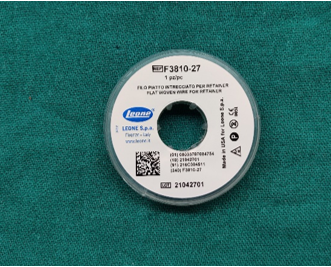
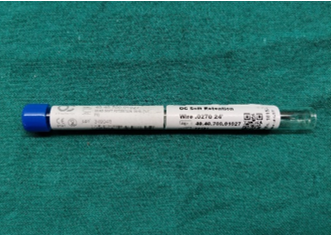
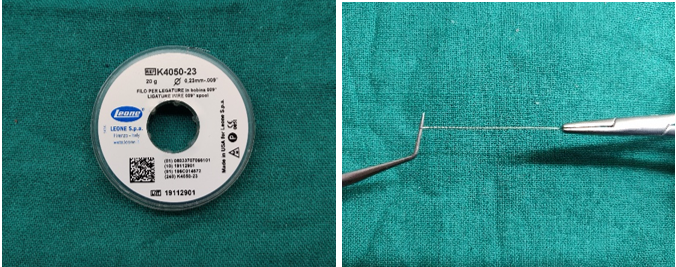


Methodology
Shear bond strength was tested using an in vitro model designed such that a vertical force could be simulated at the interdental wire between two premolars. Each pair of premolars were mounted on an acrylic block. In preparation for the testing, two premolars were placed adjacent to each other to simulate a contact point in a specimen block. Custom made twisted stainless steel ligature wire retainers were fabricated by carefully twisting two 0.009” wires (Leone) using a Mathieu plier to form a passive yet sufficiently strong bundle. The extent to which the wires were twisted (the number of twists per millimetre of wire) was similar between all specimens. The wires were twisted clockwise, six rounds per 10 mm.
The enamel surface of each tooth is cleaned with pumice, washed with distilled water and dried with air. Lingual enamel surfaces, etched with 37% orthophosphoric acid gel for the 30s, followed by thorough washing and drying. A 15 mm length of lingual retainer wire gently curved for a passive fit to the lingual surfaces of the teeth is used for each specimen. Following primer application, the wire has been bonded with light cure adhesive. A commercially available dome-shaped mold wire bonder (Mini Mold-Ortho Technology) was used to standardise the amount of composite used for each bond. Seventy-two such models were prepared and divided into six groups (Group IA, IB, IC, IIA, IIB, IIC) of 12 each ([Table 1],[Figure 6]).
|
Sl. |
Subgroup |
Details |
Sample size |
|
Group I Transbond XT |
Group IA |
Flat woven wire (Leone) |
12 |
|
Group IB |
Dead soft retention wire (Ortho Classic USA) |
12 |
|
|
Group IC |
Two stranded twisted ligature wire (0.018”) (Leone) |
12 |
|
|
Group II Ormco Enlight |
Group IIA |
Flat woven wire (Leone) |
12 |
|
Group IIB |
Dead soft retention wire (Ortho Classic USA) |
12 |
|
|
Group IIC |
Two stranded twisted ligature wire (0.018”) (Leone) |
12 |
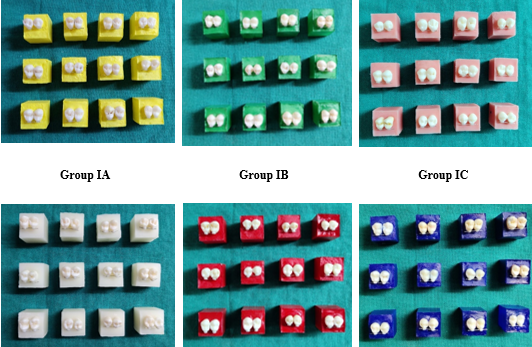
Shear bond strength was tested with a universal testing machine. Each specimen was placed and secured in the testing machine so that the chisel edge used to apply the force would not contact any part of the specimen. The vertical force was applied with the chisel edge to the midpoint of the interdental wire segment at a crosshead speed of 1 mm per minute. The bond strength was measured as the maximum force in Newton (N) to cause debonding /wire removal from the composite pad on at least one tooth in each specimen([Figure 7], [Figure 8]).
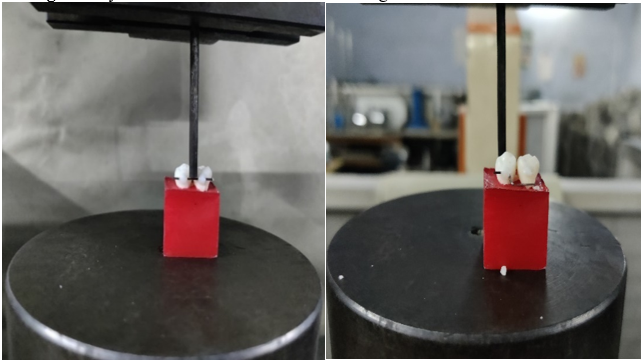
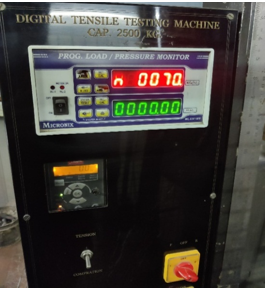
Results
Intergroup comparison between the subgroups
|
|
Mean |
Std. Deviation |
Std. Error |
95% Confidence Interval for Mean |
Minimum |
Maximum |
P-value |
|
|
Lower Bound |
Upper Bound |
|||||||
|
Sub Group IA |
99.16 |
2.918 |
0.842 |
97.312 |
101.027 |
95.00 |
104.00 |
0.001 (Sig) |
|
Sub Group IB |
88.08 |
2.234 |
0.645 |
86.663 |
89.503 |
85.00 |
92.00 |
|
|
Sub Group IC |
61.92 |
1.975 |
0.570 |
60.661 |
63.171 |
59.00 |
65.00 |
|
|
Sub Group IIA |
84.33 |
2.640 |
0.762 |
82.655 |
86.010 |
81.00 |
88.00 |
|
|
Sub Group IIB |
74.50 |
2.110 |
0.609 |
73.159 |
75.841 |
71.00 |
77.00 |
|
|
Sub Group IIC |
59.66 |
2.640 |
0.762 |
57.989 |
61.344 |
55.00 |
64.00 |
|
|
Sum of Squares |
df |
Mean Square |
F |
Sig. |
|
Between Groups |
14361.944 |
5 |
2872.38 |
481.365 |
0.001 (Sig) |
|
Within Groups |
393.833 |
66 |
5.96 |
||
|
Total |
14755.778 |
71 |
|
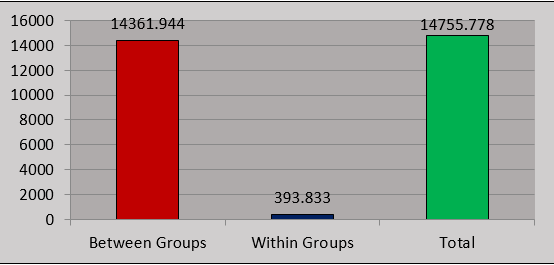
By applying one way ANOVA, there was a significant difference in means of SBS of six groups. Flat woven wire has higher shear bond strength than dead soft retention wire and ligature wire retainer.
Post Hoc analysis
|
Group IA vs Group IB |
11.083 |
0.997 |
0.001 |
Significant |
|
Group IA vs Group IC |
37.250 |
0.997 |
0.001 |
Significant |
|
Group IA vs Group IIA |
14.833 |
0.997 |
0.001 |
Significant |
|
Group IA vs Group IIB |
24.666 |
0.997 |
0.001 |
Significant |
|
Group IA vs Group IIC |
39.500 |
0.997 |
0.001 |
Significant |
|
Group IB vs Group IC |
26.166 |
0.997 |
0.001 |
Significant |
|
Group IB vs Group IIA |
3.750 |
0.997 |
0.001 |
Significant |
|
Group IB vs Group IIB |
13.583 |
0.997 |
0.001 |
Significant |
|
Group IB vs Group IIC |
28.416 |
0.997 |
0.001 |
Significant |
|
Group IC vs Group IIA |
-22.416 |
0.997 |
0.001 |
Significant |
|
Group IC vs Group IIB |
-12.583 |
0.997 |
0.001 |
Significant |
|
Group IC vs Group IIC |
2.250 |
0.997 |
0.001 |
Significant |
|
Group IIA vs Group IIB |
9.833 |
0.997 |
0.001 |
Significant |
|
Group IIA vs Group IIC |
24.667 |
0.997 |
0.001 |
Significant |
|
Group IIB vs Group IIC |
14.833 |
0.997 |
0.001 |
Significant |
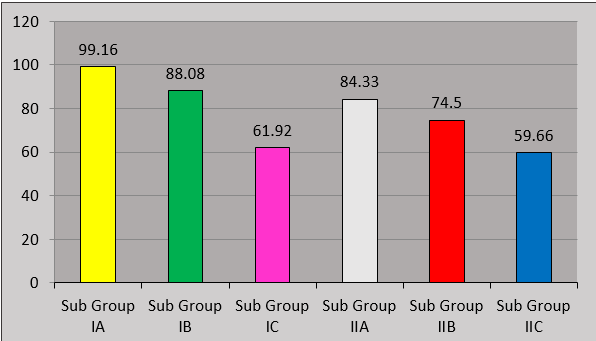
Leone flat woven wire with Transbond XT composite has the maximum shear bond strength (91.16 N).
Intergroup comparison between the groups
|
|
Mean |
Std. Deviation |
Std. Error |
95% Confidence Interval for Mean |
Minimum |
Maximum |
|
|
Lower Bound |
Upper Bound |
||||||
|
Group A |
83.055 |
16.010 |
2.668 |
77.633 |
88.472 |
59.00 |
104.00 |
|
Group B |
72.833 |
10.560 |
1.7601 |
69.263 |
76.406 |
55.00 |
88.00 |
|
T |
df |
Sig. |
Mean Difference |
Std. Error Difference |
95% Confidence Interval of the Difference |
|
|
Lower |
Upper |
|||||
|
3.198 |
70 |
0.002 |
10.222 |
3.19659 |
3.846 |
16.597 |

When comparing composite material, Transbond XT (83.005N) has greater shear bond strength than Ormco Enlight (72.833N). Leone flat woven wire with Transbond XT composite has the maximum shear bond strength. Therefore, it could be the wire-composite combination of choice for a bonded lingual retainer.
Discussion
After active treatment is complete, long-term preservation of the corrected tooth positions is desirable, both for the clinician and the patient. Retention is essential and must continue until periodontal reorganisation has been fully completed. The purpose of this in-vitro study is to investigate the shear bond strength offered by the various combinations of lingual retainer wires and composite. The bonded wire retainer is a complex system on which forces are exerted from different directions. Long-term stability studies have shown that relapse after orthodontic treatment is unfortunately unavoidable. Thus, the maintenance of treatment effects via prolonged use of retainers is widely recommended.[7], [8]
According to in vitro studies on bond strength, the detachment of a splinted wire is more frequently of cohesive type, taking place at the interface between the wire and the composite.[5], [9] Therefore, proper resins should be used to increase the bond strength with the wires, avoiding the risk of failure with possible orthodontic relapse. Different retainer wire and composite combinations had significant differences in the shear bond strength.[10]
The present study was conducted to test and compare the shear bond strength offered by the various combinations of lingual retainer wires and composites. Leone flat woven wire was used because of its high plasticity. The wire permits the exact fit to the anatomy of the tongue while its woven geometry favours the union with the composite. There is no shear bond strength study related to the Flat-woven wire. Manufacturers claim that dead-soft wire is superior to multi-stranded stainless-steel wire for constructing Flexible spiral wire retainers. It is easily adaptable and minimises the inadvertent tooth movement associated with active force wires. The intra-arch splinting with this wire prevents torque control problems when round braided wires are used. They also state that the fattened wire increases patient comfort. Hence, this study used dead soft retention wire and two stranded twisted ligature wires. Ligature wire was twisted to form two stranded wire to increase the bond strength and adaptability to the tooth surface. Transbond XT and Ormco Enlight adhesive are commonly used in orthodontic practice. Hence, they were used in this study to compare their shear bond strength. The choice of etchant, primer, length of retainer wire and the steps in bonding was all the same in the six groups to minimise chances of errors.
The shear bond strength test was recorded using an Instron Universal Testing Machine. The debonding procedure was followed according to the method prescribed by Aldrees AM et al.[3] Bond strength investigations vary in their protocols, and this lack of standardisation makes scientific comparison difficult. While most of the published studies tested materials by one loading method applied directly at the bonding site of the orthodontic attachment, very few authors have examined the wire’s interdental segment.[11]
In comparing the mean shear bond strength among six groups, ANOVA revealed a statistically significant difference (P < .001). Maximum shear bond strength was observed in group IA 98 (99.16 N), whereas the minimum was observed in group IIC (59.66N). This means that Flat woven wire has highest shear bond strength than Dead soft retention wire and Leone ligature wire. Twisted ligature wire showed the least shear bond strength. When comparing composite material, Transbond XT has greater shear bond strength than Ormco Enlight adhesive. According to Bryan and Sherriff[12], clinically acceptable mean shear bond strength for lingual bonded retainers was found to be 71 N. According to the results assessed in vitro and clinically, Transbond XT would be preferable to flowable composite when performing retainers bonding procedure.
According to Lie Sam Foek et al.[13], such in vitro studies can relate to in vivo conditions. However, more clinical studies may be needed to assess the effect of saliva, physiologic movement of teeth, functional forces of tongue, mastication, and the presence of plaque and calculus.
Therefore, from our study, it can be concluded that the most deciding factor in the shear bond strength is neither the wire nor the composite alone. It is the wire-composite combination that decides the ultimate shear bond strength. The combination of Leone Flat woven wire and Transbond XT produced the highest shear bond strength values, possibly due to the greater flowability of the resin around the strands of the wire, which increases the micromechanical retention and the flexibility of the Flat Woven wire, which adapted better to the tooth surface. All three retainer wires used in the study have a clinically acceptable mean shear bond strength. The cost and availability of the material also play a significant role in selecting the appropriate lingual retainer wire in a particular clinical situation.
Conclusion
This research attempted to assess the shear bond strength offered by the various combinations of lingual retainer wires and composites.
Maximum shear bond strength was observed in the wire-composite combination of Leone flat woven wire with Transbond XT composite.
A statistically significant difference in shear bond strength was observed between the six groups.
Transbond XT adhesive (Group I) has a greater shear bond strength than Ormco Enlight Light cure adhesive (Group II).
Leone flat woven wire with Transbond XT adhesive would be the wire-composite combination for a bonded lingual retainer.
Clinical studies are needed to validate the preliminary in vitro performance of retainers bonded to the lingual surface of the teeth. Also, further in vivo studies can be conducted to validate the findings of the present in-vitro study.
Source of Funding
None.
Conflict of Interest
None.
References
- P Salehi, H Z Najafi, S M Roeinpeikar. Comparison of survival time between two types of orthodontic fixed retainer: A prospective randomized clinical trial. Prog Orthod 2013. [Google Scholar] [Crossref]
- F A Booth, J M Edelman, W R Proffit. Twenty-year follow-up of patients with permanently bonded mandibular canine-to-canine retainers. Am J Orthod Dentofac Orthop 2008. [Google Scholar] [Crossref]
- A M Aldrees, T K Al-Mutairi, Z W Hakami, Al-Malki Mm. Bonded orthodontic retainers: a comparison of initial bond strength of different wire-and-composite combinations. J Orofac Orthop 2010. [Google Scholar] [Crossref]
- F Gunay, A A Oz. Clinical effectiveness of 2 orthodontic retainer wires on mandibular arch retention. Am J Orthod Dentofac Orthop 2018. [Google Scholar] [Crossref]
- M E Cooke, M Sherriff. Debonding force and deformation of two multi-stranded lingual retainer wires bonded to incisor enamel: An in vitro study. Eur J Orthod 2010. [Google Scholar] [Crossref]
- A Baysal, T Uysal, N Gul, M B Alan, S I Ramoglu. Comparison of three different orthodontic wires for bonded lingual retainer fabrication. Korean J Orthod 2012. [Google Scholar] [Crossref]
- R M Little, R A Riedel, J Artun. An evaluation of changes in mandibular anterior alignment from 10 to 20 years postretention. Am J Orthod Dentofac Orthop 1988. [Google Scholar] [Crossref]
- R M Little, R A Riedel. Postretention evaluation of stability and relapse-Mandibular arches with generalised spacing. Am J Orthod Dentofac Orthop 1989. [Google Scholar] [Crossref]
- A Milheiro, N D Jager, A J Feilzer, C J Kleverlaan. In vitro debonding of orthodontic retainers analyzed with finite element analysis. Eur J Orthod 2014. [Google Scholar] [Crossref]
- S Aksakalli, B Corekci, C Irgin, B Ozturk, S Malkoc. Bond strength of aged lingual retainers. J Orthod Res 2016. [Google Scholar]
- R J Radlanski, N D Zain. Stability of the bonded lingual wire retainer-a study of the initial bond strength. J Orofac Orthop 2004. [Google Scholar] [Crossref]
- D C Bryan, M Sherriff. An in vitro comparison between a bonded retainer system and a directly bonded flexible spiral wire retainer. Eur J Orthod 1995. [Google Scholar] [Crossref]
- L S Foek, D J Özcan, M Verkerke, G J Sandham, A Dijkstra. Survival of flexible, braided, bonded stainless steel lingual retainers: A historic cohort study. Eur J Orthod 2008. [Google Scholar] [Crossref]
